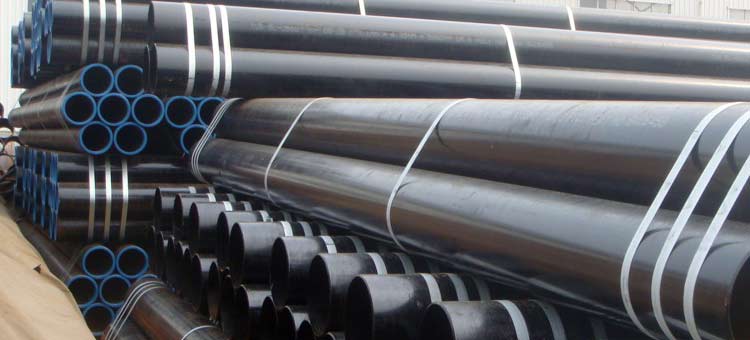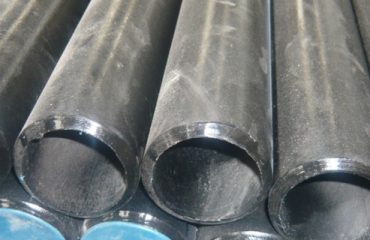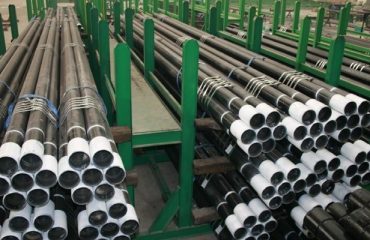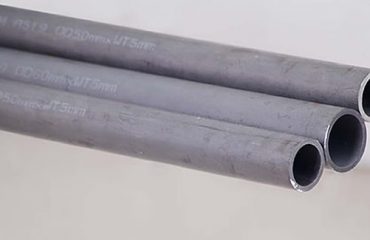
ASTM A672 Electrofusion Welded (EFW) Paip Keluli
pengenalan
ASTM A672 ialah spesifikasi yang meliputi kimpalan gabungan elektrik (EFW) paip keluli direka untuk perkhidmatan tekanan tinggi pada suhu sederhana. Paip ini biasanya digunakan dalam industri seperti penjanaan kuasa, petrokimia, minyak dan gas, dan penghantaran air. Spesifikasi menyediakan garis panduan untuk pembuatan, ujian, dan pemeriksaan paip keluli untuk memastikan ia memenuhi sifat mekanikal yang diperlukan dan keperluan prestasi untuk aplikasi tekanan tinggi.
Proses EFW ialah kaedah kimpalan yang menggunakan arka elektrik untuk menggabungkan plat keluli bersama-sama, membentuk jahitan membujur. Proses ini sangat cekap dan menghasilkan paip dengan integriti struktur dan kekuatan mekanikal yang sangat baik. Paip ASTM A672 boleh didapati dalam pelbagai gred berdasarkan jenis keluli yang digunakan dan sifat mekanikal yang diperlukan.
Artikel ini akan meneroka proses pembuatan, Sifat Mekanikal, dan aplikasi paip keluli ASTM A672 EFW, serta kaedah ujian yang digunakan untuk memastikan mereka kualiti dan prestasi.
Jadual Kandungan
- Apakah Paip Keluli ASTM A672 EFW?
- Proses Pembuatan Paip Keluli ASTM A672 EFW
- Kimpalan Gabungan Elektrik (EFW) Proses
- rawatan haba
- Gred dan Kelas Paip Keluli ASTM A672
- Sifat Mekanikal Paip Keluli ASTM A672 EFW
- Keperluan Pengujian dan Pemeriksaan
- ujian tanpa musnah (NDT)
- Ujian Hidrostatik
- Aplikasi Paip Keluli ASTM A672 EFW
- Soalan Lazim (Soalan Lazim)
- Kesimpulan
Apakah Paip Keluli ASTM A672 EFW? {#apakah-astm-a672-efw-steel-pipe}
ASTM A672 ialah spesifikasi standard untuk kimpalan gabungan elektrik (EFW) paip keluli direka untuk perkhidmatan tekanan tinggi pada suhu sederhana. Paip ini dibuat daripada bekas tekanan kualiti plat keluli yang dikimpal gabungan menggunakan arka elektrik. Spesifikasi meliputi paip dengan jahitan membujur dan bertujuan untuk digunakan dalam aplikasi di mana kekuatan dan ketahanan yang tinggi diperlukan.
Ciri -ciri utama Pipa Keluli EFW ASTM A672:
-
Gabungan Elektrik Dikimpal (EFW): Paip dihasilkan menggunakan proses EFW, yang melibatkan menggabungkan plat keluli bersama menggunakan arka elektrik. Proses ini menghasilkan kimpalan membujur yang kuat yang dapat menahan tekanan yang tinggi.
-
Tekanan Kapal kualiti keluli: Plat keluli yang digunakan dalam pembuatan paip ASTM A672 adalah kualiti kapal tekanan, bermaksud mereka direka untuk menahan tekanan dalaman yang tinggi tanpa kegagalan.
-
Perkhidmatan tekanan tinggi: Paip ASTM A672 sesuai untuk aplikasi tekanan tinggi, seperti dandang, Penukar Haba, dan saluran paip dalam industri minyak dan gas.
-
Aplikasi suhu sederhana: Spesifikasi meliputi paip yang direka untuk digunakan pada suhu sederhana, biasanya sehingga 400°C (752° F).
-
Pelbagai Gred: Paip ASTM A672 tersedia dalam gred berbeza berdasarkan jenis keluli yang digunakan dan sifat mekanikal yang diperlukan. Gred ditentukan oleh komposisi kimia dan rawatan haba keluli.
Proses Pembuatan Paip Keluli ASTM A672 EFW {#proses pembuatan-paip-astm-a672-efw-keluli}
Pembuatan paip keluli ASTM A672 EFW melibatkan beberapa langkah, termasuk pemilihan plat keluli berkualiti kapal tekanan, kimpalan gabungan elektrik (EFW) Proses, dan rawatan haba untuk mencapai sifat mekanikal yang diingini.
Kimpalan Gabungan Elektrik (EFW) Proses {#proses kimpalan-penyatuan-elektrik-efw}
Proses EFW ialah sejenis kimpalan arka yang menggunakan arka elektrik untuk menggabungkan plat keluli bersama-sama di sepanjang jahitan membujur. Proses tersebut melibatkan langkah-langkah berikut:
-
Penyediaan Pinggan: Plat keluli dipotong pertama ke dimensi yang diperlukan dan diperiksa untuk sebarang kecacatan permukaan atau ketidaksempurnaan.
-
Penyediaan tepi: Tepi plat keluli dibuang untuk memastikan gabungan yang betul semasa proses kimpalan. Sudut serong dikawal dengan teliti untuk mencapai kimpalan yang kuat.
-
Kimpalan Gabungan Elektrik: Plat diposisikan ke tepi ke tepi, dan arka elektrik digunakan untuk mencairkan tepi pinggan, Membuat Kolam Kimpalan. Semasa arka bergerak sepanjang jahitan, logam cair menguatkan, membentuk kimpalan berterusan sepanjang panjang paip.
-
Pemeriksaan kimpalan: Kimpalan diperiksa kerana kecacatan seperti keliangan, retak, atau gabungan yang tidak lengkap. Ujian Tidak Memusnahkan (NDT) kaedah, seperti ujian ultrasonik atau ujian radiografi, sering digunakan untuk memastikan kualiti kimpalan.
-
Ukuran dan membentuk: Selepas mengimpal, the pipe is passed through a series of rollers to achieve the desired diameter and roundness. The pipe is also inspected for dimensional accuracy.
rawatan haba {#heat-treatment}
After the EFW process, the pipes may undergo heat treatment to improve their mechanical properties and relieve residual stresses induced during welding. The type of heat treatment depends on the grade of the steel and the application requirements. Common heat treatment processes include:
-
Menormalkan: The pipe is heated to a temperature above its critical point and then cooled in air. This process refines the grain structure and improves the toughness of the steel.
-
Quenching and Tempering: The pipe is heated to a high temperature and then rapidly cooled (dipadamkan) in water or oil. It is then reheated to a lower temperature (marah) untuk meningkatkan kemuluran dan keliatannya.
-
Melegakan tekanan: Paip dipanaskan pada suhu sederhana dan kemudian disejukkan perlahan-lahan untuk melegakan tegasan sisa tanpa mengubah sifat mekanikal dengan ketara.
Gred dan Kelas Paip Keluli ASTM A672 {#gred-dan-kelas-paip-astm-a672-keluli}
Paip keluli ASTM A672 boleh didapati dalam pelbagai gred dan kelas berdasarkan jenis keluli yang digunakan dan sifat mekanikal yang diperlukan. Gred ditentukan oleh komposisi kimia keluli, manakala kelas adalah berdasarkan keperluan rawatan haba dan ujian.
Gred Biasa:
-
Gred B60: Gred ini diperbuat daripada keluli karbon dengan kekuatan tegangan minimum 415 MPa (60,000 psi). Ia biasanya digunakan untuk aplikasi tekanan sederhana.
-
Gred C65: Gred ini diperbuat daripada keluli karbon-mangan dengan kekuatan tegangan minimum 450 MPa (65,000 psi). Ia sesuai untuk aplikasi tekanan tinggi.
-
Gred C70: Gred ini diperbuat daripada keluli karbon-mangan dengan kekuatan tegangan minimum 485 MPa (70,000 psi). It is used in high-pressure applications where strength and durability are critical.
Kelas:
- Kelas 10: Pipes in this class are supplied in the as-welded condition without any heat treatment.
- Kelas 12: Pipes in this class are heat-treated after welding to improve their mechanical properties and relieve residual stresses.
- Kelas 22: Pipes in this class undergo quenching and tempering to achieve higher strength and toughness.
Material Specification {#material-specification}
ASTM A672 pipes are made from pressure vessel quality steel plates that are welded using the Kimpalan Gabungan Elektrik (EFW) Proses. The specification covers pipes in various Gred dan Kelas, which are determined by the komposisi kimia of the steel and the rawatan haba applied after welding.
Ciri -ciri utama Pipa Keluli EFW ASTM A672:
- Gabungan Elektrik Dikimpal (EFW): Pipes are welded using an electric arc to fuse steel plates, creating a longitudinal weld.
- Pressure Vessel Quality Steel: The steel plates used are of pressure vessel quality, ensuring the pipes can withstand high internal pressures.
- Perkhidmatan tekanan tinggi: ASTM A672 pipes are designed for Aplikasi tekanan tinggi di moderate temperatures.
- Grades and Classes: The specification provides multiple Gred dan Kelas based on the komposisi kimia dan rawatan haba of the steel.
Jadual Komposisi Kimia {#chemical-composition-table}
The chemical composition of ASTM A672 steel pipes varies depending on the Gred of the steel used. The table below outlines the typical chemical composition for common grades used in ASTM A672 pipes.
| ELEMEN | Gred B60 (%) | Gred C65 (%) | Gred C70 (%) |
|---|---|---|---|
| Karbon (C) | 0.26 Max | 0.24 Max | 0.23 Max |
| deposit (MN) | 0.98 Max | 1.20 Max | 1.35 Max |
| fosfor (P) | 0.035 Max | 0.035 Max | 0.035 Max |
| sulfur (S) | 0.035 Max | 0.035 Max | 0.035 Max |
| silikon (Si) | 0.13-0.45 | 0.13-0.45 | 0.13-0.45 |
| kromium (Cr) | 0.30 Max | 0.30 Max | 0.30 Max |
| Nikel (Ni) | 0.30 Max | 0.30 Max | 0.30 Max |
| Molybdenum (Mo) | 0.12 Max | 0.12 Max | 0.12 Max |
| Tembaga (Cu) | 0.40 Max | 0.40 Max | 0.40 Max |
| vanadium (V) | 0.08 Max | 0.08 Max | 0.08 Max |
Nota:
- Kandungan Karbon is a key factor in determining the kekuatan dan Kekerasan of the steel. Lower carbon content improves kebolehkimpalan dan kemuluran.
- deposit improves the Kekuatan Tegangan dan hardenability of the steel.
- fosfor dan sulfur are kept at low levels to prevent Brittleness dan improve toughness.
- silikon acts as a deoxidizer during the steelmaking process and improves kekuatan.
Mechanical Properties Table {#mechanical-properties-table}
The mechanical properties of ASTM A672 steel pipes are determined by the Gred dan Kelas daripada paip itu, as well as the rawatan haba applied after welding. Jadual di bawah menyediakan sifat mekanikal biasa untuk gred biasa paip ASTM A672.
| Harta benda | Gred B60 | Gred C65 | Gred C70 |
|---|---|---|---|
| Kekuatan Tegangan (MPa) | 415 min (60,000 psi) | 450 min (65,000 psi) | 485 min (70,000 psi) |
| Menghasilkan Kekuatan (MPa) | 240 min (35,000 psi) | 275 min (40,000 psi) | 275 min (40,000 psi) |
| Elongation (%) | 22 min | 22 min | 22 min |
| Ketangguhan Kesan (J) | Berbeza mengikut kelas | Berbeza mengikut kelas | Berbeza mengikut kelas |
Nota:
- Kekuatan Tegangan adalah tekanan maksimum yang boleh ditahan oleh bahan sebelum pecah.
- Menghasilkan Kekuatan ialah tegasan di mana bahan mula berubah bentuk secara plastis.
- Elongation adalah ukuran kemuluran bahan, menunjukkan berapa banyak ia boleh meregang sebelum pecah.
- Ketangguhan Kesan biasanya diukur menggunakan Ujian takuk V Charpy, terutamanya untuk aplikasi dalam persekitaran suhu rendah.
Keperluan Pengujian dan Pemeriksaan {#keperluan ujian-dan-pemeriksaan}
Untuk memastikan kualiti dan prestasi paip keluli ASTM A672 EFW, beberapa kaedah ujian dan pemeriksaan digunakan semasa proses pembuatan. Ujian ini membantu mengenal pasti sebarang kecacatan atau ketidakkonsistenan dalam bahan atau kimpalan yang boleh menjejaskan sifat mekanikal paip atau integriti struktur..
ujian tanpa musnah (NDT) {#nondestructive-testing-ndt}
ujian tanpa musnah (NDT) Kaedah digunakan untuk memeriksa jahitan kimpalan dan badan paip untuk kecacatan tanpa merosakkan bahan. Kaedah NDT biasa termasuk:
-
Ujian Ultrasonik (OUT): Gelombang ultrasonik digunakan untuk mengesan kecacatan dalaman seperti retak, lompang, atau gabungan tidak lengkap di badan kimpalan atau paip.
-
Ujian Radiografi (RT): Sinar-X atau sinar gamma digunakan untuk membuat imej kimpalan, membenarkan pemeriksa mengenal pasti kecacatan dalaman seperti keliangan, Kemasukan Slag, atau retak.
-
Ujian Zarah Magnetik (MT): Kaedah ini digunakan untuk mengesan kecacatan permukaan dalam bahan ferromagnetik. Medan magnet digunakan pada paip, dan zarah besi digunakan untuk mendedahkan sebarang keretakan atau ketidakselarasan di permukaan.
-
pewarna ujian penusukan (PT): Pewarna digunakan pada permukaan paip, dan sebarang keretakan atau kecacatan akan menyerap pewarna, menjadikan mereka kelihatan di bawah cahaya ultraviolet.
Ujian Hidrostatik {#ujian hidrostatik}
Ujian Hydrostatic adalah ujian kritikal yang digunakan untuk memastikan bahawa paip dapat menahan tekanan dalaman yang akan dikenakan dalam perkhidmatan. Semasa ujian ini, Paip dipenuhi dengan air dan bertekanan ke tahap yang lebih tinggi daripada tekanan operasinya. Paip kemudian diperiksa untuk sebarang kebocoran atau ubah bentuk yang mungkin menunjukkan kelemahan dalam bahan atau kimpalan.
- Tekanan ujian: Tekanan ujian biasanya 1.5 kali tekanan reka bentuk paip.
- Tempoh: Paip diadakan pada tekanan ujian untuk tempoh yang ditentukan (biasanya 5 untuk 15 minit) untuk memastikan ia dapat mengekalkan tekanan tanpa kegagalan.
Aplikasi Paip Keluli ASTM A672 EFW {#Aplikasi-of-AAST-A672-EFW-Steel-Pipe}
Paip keluli EFW ASTM A672 digunakan dalam pelbagai industri dan aplikasi di mana perkhidmatan tekanan tinggi dan integriti struktur adalah kritikal. Beberapa aplikasi biasa termasuk:
-
penjanaan kuasa: Paip ASTM A672 digunakan dalam dandang, Penukar Haba, dan saluran paip wap di loji kuasa kerana keupayaannya untuk menahan tekanan tinggi dan suhu sederhana.
-
industri petrokimia: Paip ini digunakan di kilang penapisan, tumbuhan kimia, dan kemudahan petrokimia untuk mengangkut cecair dan gas yang menghakis di bawah tekanan tinggi.
-
Industri minyak dan gas: Paip ASTM A672 digunakan dalam saluran paip minyak dan gas, Platform luar pesisir, dan saluran paip bawah laut untuk mengangkut minyak mentah, gas asli, dan hidrokarbon lain.
-
Penghantaran Air: Paip ini digunakan dalam sistem penghantaran air untuk mengangkut air yang boleh diminum, air kumbahan, dan air industri di bawah tekanan tinggi.
-
Aplikasi Struktur: Paip ASTM A672 digunakan dalam aplikasi struktur seperti tiang, rasuk, dan sokongan dalam bangunan dan struktur perindustrian di mana kekuatan dan ketahanan diperlukan.
Soalan Lazim (Soalan Lazim) {#Soalan Lazim}
1. Apakah perbezaan antara paip EFW dan ERW?
EFW (Gabungan Elektrik Dikimpal) paip dikimpal menggunakan arka elektrik untuk menggabungkan plat keluli bersama-sama, manakala ERW (Rintangan elektrik golek) paip dikimpal menggunakan rintangan elektrik untuk memanaskan tepi keluli dan menggabungkannya bersama-sama. Paip EFW biasanya digunakan untuk aplikasi tekanan tinggi, manakala paip ERW digunakan untuk aplikasi tekanan rendah hingga sederhana.
2. Apakah gred biasa paip ASTM A672?
Gred biasa paip ASTM A672 termasuk Gred B60, Gred C65, dan Gred C70, yang berdasarkan komposisi kimia dan sifat mekanikal keluli.
3. Apakah suhu operasi maksimum untuk paip ASTM A672?
Paip ASTM A672 direka untuk digunakan pada suhu sederhana, biasanya sehingga 400°C (752° F), bergantung pada gred dan kelas paip.
4. Bagaimanakah kualiti paip ASTM A672 dipastikan?
Kualiti paip ASTM A672 dipastikan melalui ujian tidak merosakkan (NDT) kaedah seperti ujian ultrasonik, Ujian Radiografi, dan ujian zarah magnet, serta ujian hidrostatik untuk mengesahkan keupayaan paip untuk menahan tekanan dalaman.
5. Industri apa yang menggunakan paip keluli EFW ASTM A672?
Paip keluli EFW ASTM A672 digunakan dalam industri seperti penjanaan kuasa, petrokimia, minyak dan gas, dan penghantaran air kerana keupayaan mereka untuk menahan tekanan yang tinggi dan suhu sederhana.
Kesimpulan {#Kesimpulan}
Paip keluli EFW ASTM A672 direka untuk perkhidmatan tekanan tinggi pada suhu sederhana, menjadikan mereka sesuai untuk digunakan dalam industri seperti penjanaan kuasa, petrokimia, minyak dan gas, dan penghantaran air. kimpalan gabungan elektrik (EFW) proses memastikan kimpalan membujur yang kuat yang dapat menahan tekanan dalaman yang tinggi, Walaupun penggunaan keluli kualiti kapal tekanan memastikan paip mempunyai sifat mekanikal yang diperlukan untuk menuntut aplikasi.
Keperluan ujian dan pemeriksaan yang digariskan dalam ASTM A672, termasuk ujian tidak musnah dan ujian hidrostatik, membantu memastikan kualiti dan prestasi paip, menjadikannya pilihan yang boleh dipercayai untuk aplikasi tekanan tinggi dan struktur.




anda mesti log masuk untuk menghantar komen.